10 Companion Plants for Daylilies (With Pictures)
-
Pete Ortiz
- Last updated:

There are not many perennial plants that are suited to landscape designs more than daylilies. Botanically referred to as Hemerocallis, these stunning plants come in an array of different colors. They are resilient, virtually pest and disease free, and can adapt to any kind of soil. They can also grow just about anywhere provided they get direct sunlight exposure for a full day.
Despite being easy to care for, you still have to be cautious about what plants you grow next to daylilies. Finding the right companion plants for your daylilies can be challenging because you must match the growing conditions for the pair to match and thrive.
In this article, we have compiled a list of the best companion plants for daylilies. The article will also highlight bad companions for the plant as well as the best growing conditions for daylilies to thrive.

The 10 Best Companion Plants for Daylilies
Since daylilies have such vibrant colors, choosing the right companion can significantly enhance the beauty of your daylily garden. Before you pair them with other plants, you must consider the requirements, similarities, and preferences of both plants. This way you can provide a mutually beneficial environment for all plants in your home garden.
Here are some of the best daylilies companions:
1. Phlox (Phlox paniculata)

| Size: | 6 inches to 5 feet high, depending on the variety |
| Colors: | Magenta, pink, rose, white, purple, white, blue, and pink |
| Varieties: | Starfire phlox, volcano ruby, and david phlox |
The phlox plant genus is commonly found in Europe, North America, and Asia. They make great border plants and can thrive alongside daylilies. These plants are popularly known for their vibrant colors that are seen from late spring to later summer.
Like daylilies, they do well in well-draining soil and require adequate exposure to sunlight.1 However, they also appreciate a light shade during those hot summer months. Moreover, as low-growing plants, they make a great natural ground cover.
Phlox plants feature upright stems with full and strong dome-shaped flowers that stay vibrant on-season, complementing daylilies.
2. Black-eyed Susan (Rudbeckia hirta)
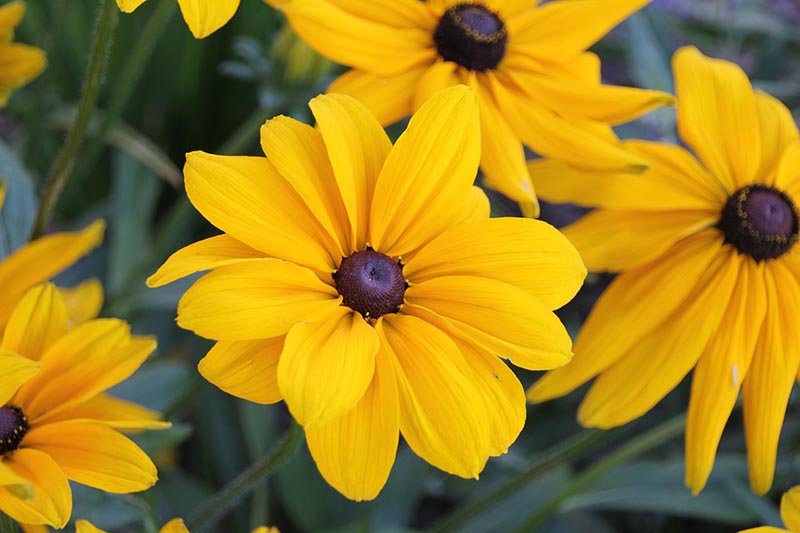
| Size: | 2–3 feet high, 1–2 feet wide |
| Colors: | Yellow and orange |
| Varieties: | Moreno, indian summer, and prairie sun |
Black-eyed Susan is a wildflower species native to North America. This plant features brown or orange flowers that usually grow in clumps and bloom in summer. However, sometimes, you can get dark brown or black flowers with yellow centers.
This plant is strong enough to handle different environments, including semi-arid and arid areas. It makes a great companion for daylilies because their different color spectrums complement each other well.
As an annual plant, black-eyed Susan can grow up to 2–3 feet tall with a width of 1–2 feet. Moreover, it prefers well-draining soil that can be either moist or dry depending on where you reside. When left to its devices, black-eyed susans can thrive in the same environment as daylilies creating beautiful splashes of color in your garden.
3. Salvia (Salvia officinalis)
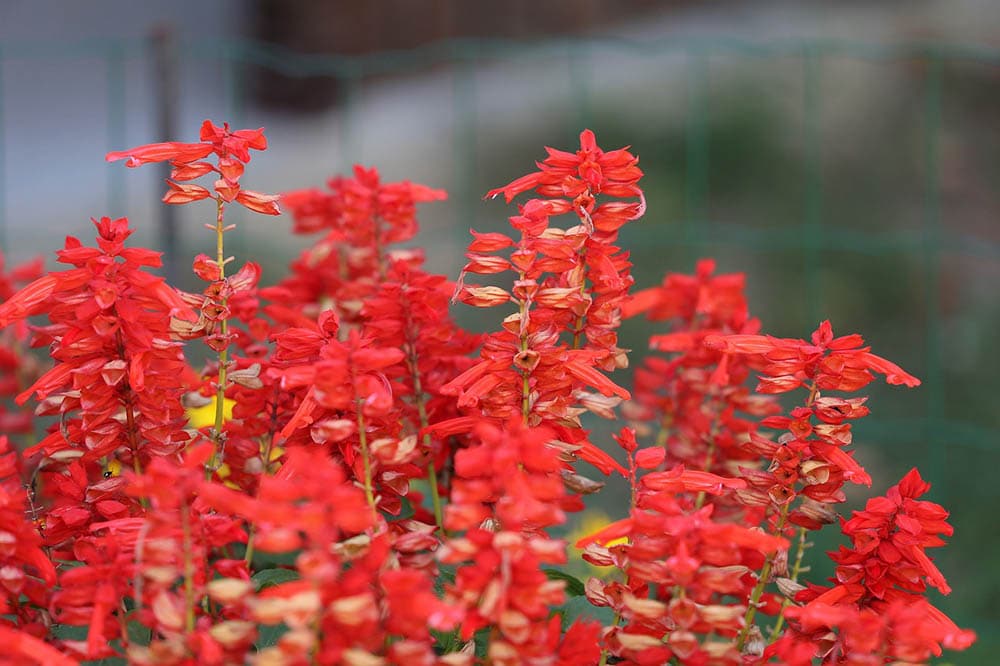
| Size: | 20 inches tall and wide |
| Colors: | Blue, white, red, and purple |
| Varieties: | Amistad, balkan sage, caradonna, and gentian sage |
Also known as ornamental sage, salvia usually blooms in summer to produce tube-like and hollow flowers with colors that range from bright blue to purple. It is a great daylily companion plant that looks particularly stunning when planted under tall daylily stems or in border regions.
Like most daylily companion plants, salvia thrives in wet and well-draining soil. It also prefers access to full sunlight just like daylilies.
4. Bee Balm (Monarda)
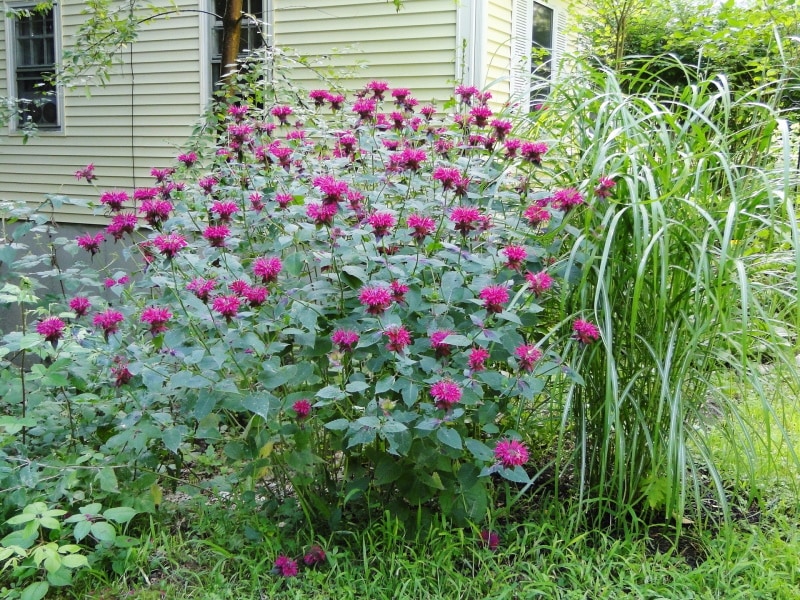
| Size: | 2–4 feet high, 3–4 feet wide |
| Colors: | Pink, purple, red, and white |
| Varieties: | Monarda didyma, Monarda pringlei, Monarda fistulosa |
Bee balm is a wonderful companion plant for daylilies because they share similar growing conditions. This plant thrives in wet loamy soil and under direct sunlight. When bee balm blooms during late summer or early autumn, it produces vibrant flower heads with various colors that complement the flowers of daylilies.
This plant can liven up your garden, especially when the other flowers die in late summer and early autumn.
5. Yarrow (Achillea millefolium)
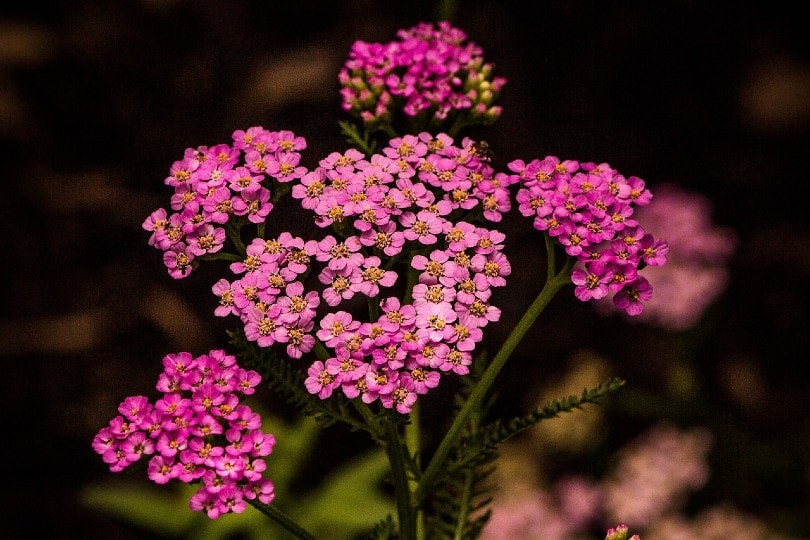
| Size: | 2–3 feet high and wide |
| Colors: | Purple |
| Varieties: | Cerise queen, little moonshine, and apple blossom |
Yarrow is a perennial plant that produces daisy-type flower clusters on long stems that can grow to heights of up to 2–3 feet. This plant species is propagated through the division method and requires well-draining soil and exposure to full sun to thrive. However, it can also do well in poorly draining soil or dry soil types. When planted, it typically needs to be spaced at least 12–24 inches apart to produce multiple plants.
The yarrow plant is also drought resistant and perennial and can be found in many home gardens. Sure, yarrow may be victim to powdery mildew and botrytis, but they can be treated using fungicides Also, it produces secretions that can help boost disease resistance in daylilies and any other plants growing nearby.
6. Coneflower (Echinacea purpurea)
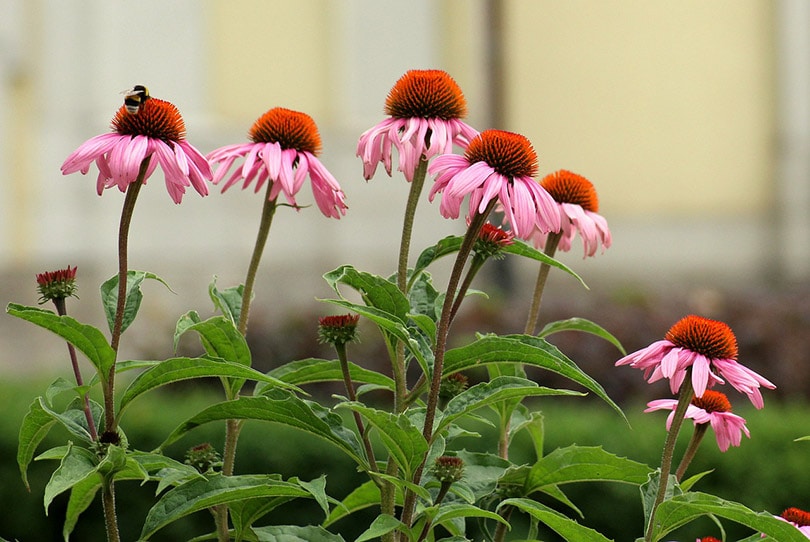
| Size: | 2–5 feet tall and wide |
| Colors: | Purple |
| Varieties: | Powwow wild berry, pink double delight, maxima, and double-decker |
The cornflower blooms to produce flowers in varying colors ranging from red, orange, pink, purple, and chartreuse. It is an easy-to-grow, heat and drought-resistant plant. Moreover, when cut, it can make a lovely gift.
The cornflower is part of the Asteraceae family that is native to North America. There are nine species of this flowering plant but only three are grown in home gardens. They include Echinacea angustifolia, Echinacea purpurea, and Echinacea pallida.
Echinacea purpurea, also known as purple coneflowers, is the best subspecies to grow alongside daylilies. They tend to produce flowers with petals facing downwards with domed orange-brown centers. These flowers usually bloom during midsummer or early autumn. They also thrive in moderate draining soil and under the full glare of the sun, reaching heights of up to 5 feet.
However, some plants can also do well in partial shade, and when planted alongside daylilies, they attract pollinators and birds to the flowers and help fill up your daylily garden.
7. Zinnia (Zinnia)
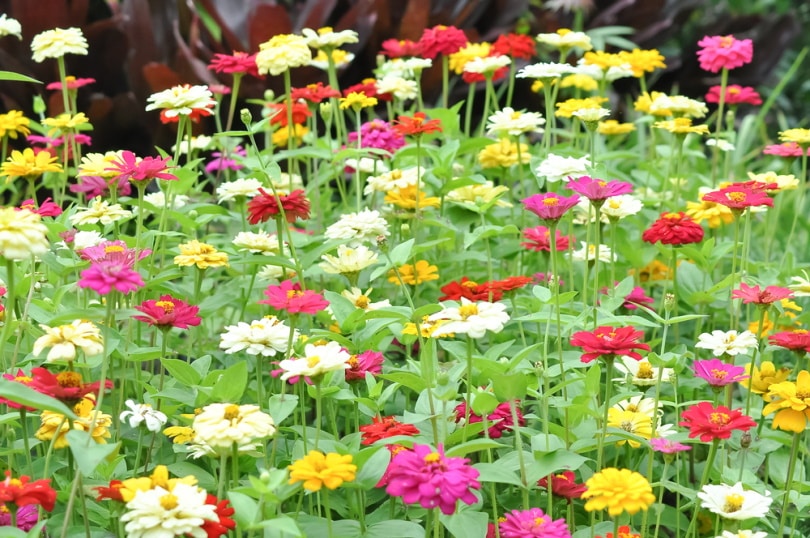
| Size: | 6 inches to 4 feet, depending on variety |
| Colors: | White, red, gold, orange, fuchsia, purple, and multicolored |
| Varieties: | Queen red lime, peppermint stick, and uproar rose |
The Zinnia is a great option as a companion plant because it comes with varying colors ranging from orange to brilliant red. These colors can perfectly complement those produced by daylilies. Zinnia also thrives in well-draining soil and full sunlight exposure.
Their size may vary from 6 inches to 4 feet and are great as companion plants when growing in a sunny border location in your yard. Furthermore, they bloom from early spring to late autumn adding a splash of colors to your garden.
8. Russian Sage (Perovskia atriplicifolia)
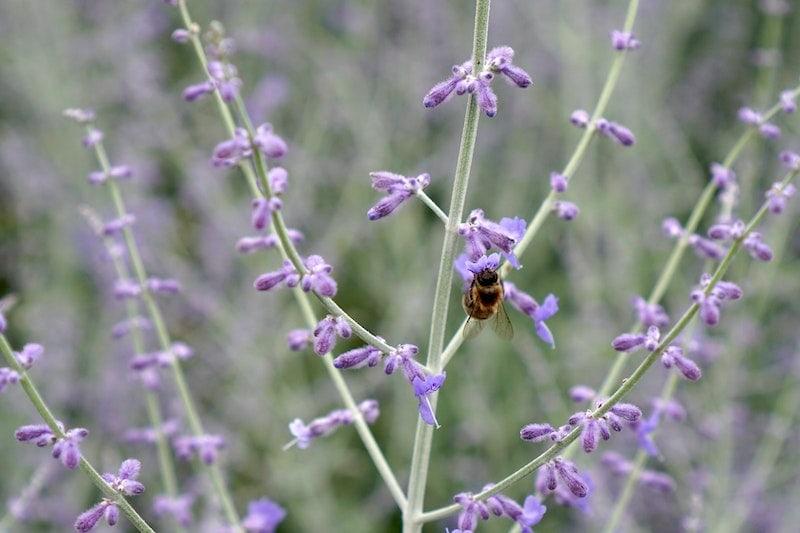
| Size: | 47 inches tall, 39 inches wide |
| Colors: | Purple |
| Varieties: | Blue mist blue jean baby and blue spire |
The Russian sage is a wonderful daylily companion shrub due to its upright spikes that complement the appearance of daylilies. This plant is often grown next to daylilies or in the center of a flower bed. Russian sage is also a hardy plant and thrives in direct sunlight and well-draining soil.
9. Coral Bells (Heuchera)
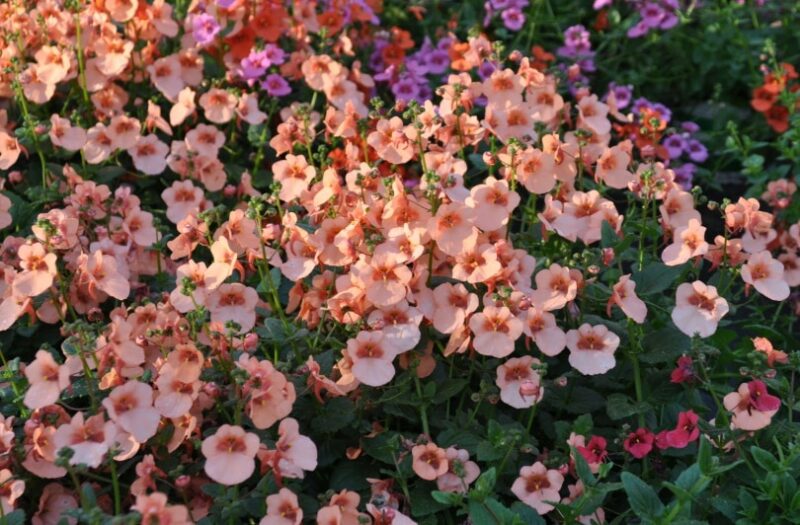
| Size: | 8–17 inches high, 10–24 inches wide |
| Colors: | White, red, pink, coral, and orange |
| Varieties: | Green spice, chocolate truffles, and marmalade |
The coral bell plant features foliage in shades of rose, purple, and gold, among other hues that perfectly match the colors of daylilies. As a low-growing plant, it provides excellent ground cover and looks stunning when grown as a border plant.
The plant prefers wet but well-draining soil and full sunlight rays or partial shade to do well. It also produces sensitive bell-shaped flowers in spring and early summer that can liven up your garden with a splash of color.
10. Petunia (Petunia)
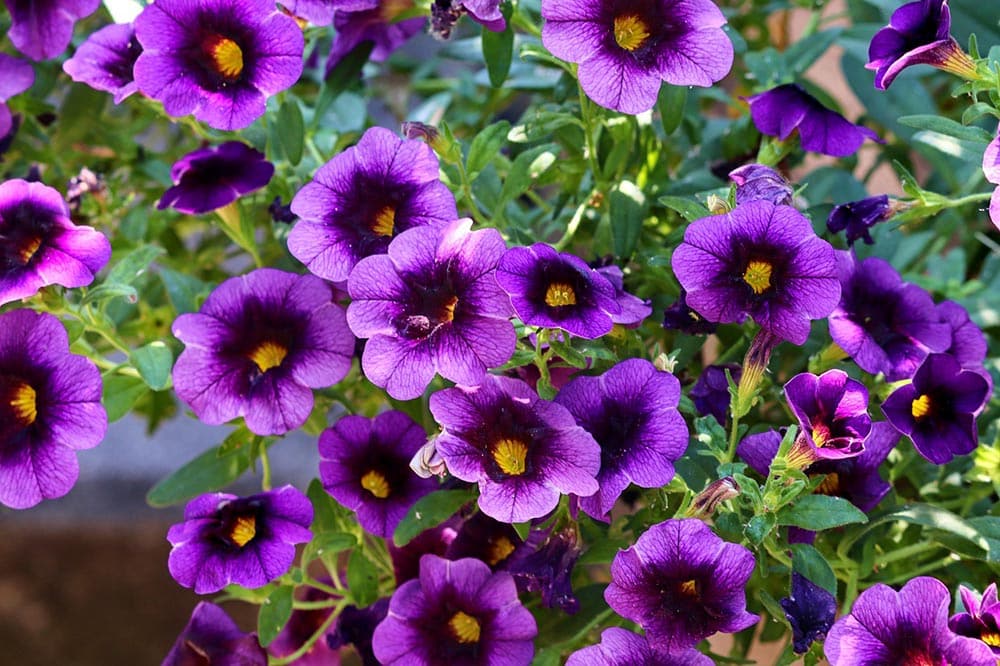
| Size: | 18 inches high, 3 inches wide |
| Colors: | Pink, white, purple, red, blue, and multicolored |
| Varieties: | Night sky, craxytunia, and thumbelina |
The petunia plant grows in various shapes and colors. It is a perfect daylily companion because it offers ground bedding and is also great as a border plant. When planted alongside daylilies, you can expect to have vibrant colors in your garden from summer through to autumn.
Furthermore, petunia prefers full sun, fertile soil, and frequent watering in dry conditions.
Worst Companion Plants for Daylilies
In a garden, some plants tend to thrive next to daylilies, availing beneficial nutrients and deterring pesky pets. In contrast, some plants will inhibit their growth by limiting the amount of water, space, and nutrients, as well as attracting insects that can be harmful to daylilies.
- Tall Plants: They tend to cover the flowers, making their stems weak and unable to produce as many blooms as they initially should.
- Plants That Spread on Wide Surfaces: These will likely block sunlight, preventing the rays from reaching the daylily leaves. Consequently, your daylilies will not be able to grow to optimum heights and produce enough foliage.
- Significantly Short Plants: If too short, the roots of the plants will be forced to compete with daylilies for soil nutrients. However, if daylilies are growing next to tall companion plants, you can add shorter ground cover plants between and on top of the bulb clumps. This way, they can cover the ground while still allowing the sun to penetrate through at ground level.
How to Choose Companion Plants
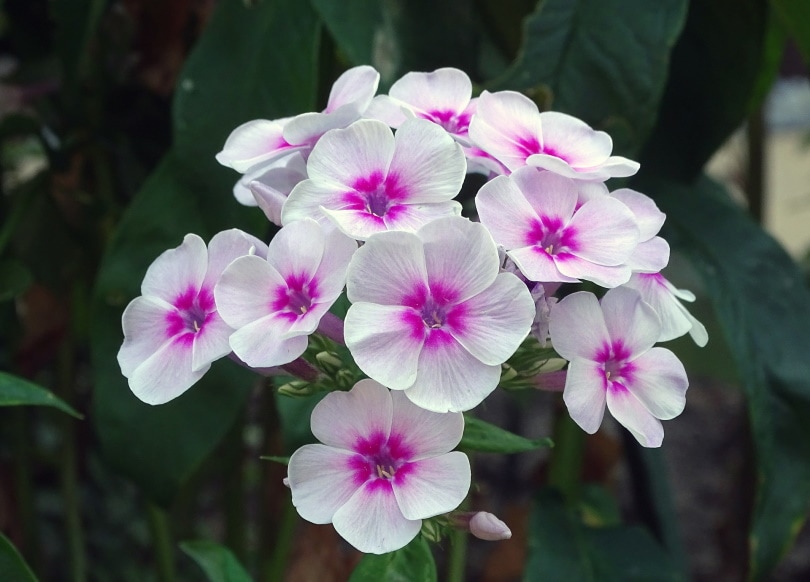
As earlier mentioned, daylilies are easy to grow with minimal maintenance practices. This is perhaps why they are often referred to as “the lazy gardener’s plant”—because they can tolerate neglect. Nevertheless, it is important to consider some growing requirements to help you choose companions that fit into the same requirements.
- Watering: Sure, daylilies are drought resistant, yet you will get better results if you provide the correct water regimen. Before watering, test the moisture content in the top layer of the soil. If the soil immediately below the top 2 inches is still dry, then proceed to water the plant, moistening the soil up to a depth of 8–10 inches. Furthermore, be cautious not to water during the day in the blooming season.
- Fertilizing: If you opt to give your daylilies commercially produced fertilizer, ensure that it has nitrogen nutrients in a slow-release form. Ideally, it should have 50% of nitrogen. Most soluble nitrogen fertilizers feature 10-10-10 and 12-12-12 nitrogen content, urea, and ammonium nitrate. These fertilizers can prompt excessive leaf and stem growth at the expense of producing flowers. These fertilizers can also burn the plant leaves if sprayed in a liquid form.
- PH Control: Daylilies can thrive in both acidic and alkaline soils. However, they prefer a PH level of 6.0 to 6.5¹. If your soil is acidic, you can lower the PH level by adding peat moss when planting your lilies for the first time. If you forgot and skipped this step, you can still make your soil acidic by adding sulfur. If the soil PH is low, consider adding lime, ideally in the form of calcium carbonate capsules or pellets.
- Mulching: Adding mulch to a garden helps conserve moisture and inhibit weed growth. Moreover, as the mulch decays, it fertilizes the soil. Some acceptable mulch for daylilies includes hay, pine straw, and shredded leaves. When mulching, ensure that it is placed at least 5 centimeters away from your daylily crowns and is only done in the growing season to prevent rot and water accumulation in the soil.
- Weed Control: The best way to remove weeds from your daylily garden is by pulling them out by hand. However, ensure that you do not root out the companion plant. Add the uprooted weeds to a compost heap for later use. You can also control weeds by mulching or reducing the amount of water you give your daylilies in the summer.

Conclusion
Growing companion plants next to your daylilies benefits both plants from an aesthetic and health point of view. They cannot only deter pests and prevent certain diseases from affecting your daylilies but can also protect any vulnerable plants growing nearby. Moreover, they can ensure that your garden has vibrant colors throughout the changing seasons.
Your choice of a companion plant will depend on the similarities, requirements, and growing conditions between daylilies and the plant you intend to pair. If unsure of what companion plants to use in your garden, you can stick to yarrow, Russian sage, phlox, or zinnia for a stunning color variation in your garden.
- You Might Also Be Interested In How & When to Plant Black-eyed Susan
- https://plantophiles.com/houseplant-tips/light-levels-for-plants/
- https://journals.plos.org/plosone/article?id=10.1371%2Fjournal.pone.0218563
- https://bustlingnest.com/care-daylilies/
- https://www.finegardening.com/article/designing-a-beautiful-back-border-planting-plan
- https://www.backyardgardenlover.com/companion-plants-for-daylilies/
- https://homeguides.sfgate.com/companion-plants-daylilies-41183.html
Featured Image Credit: Hans, Pixabay
Contents


